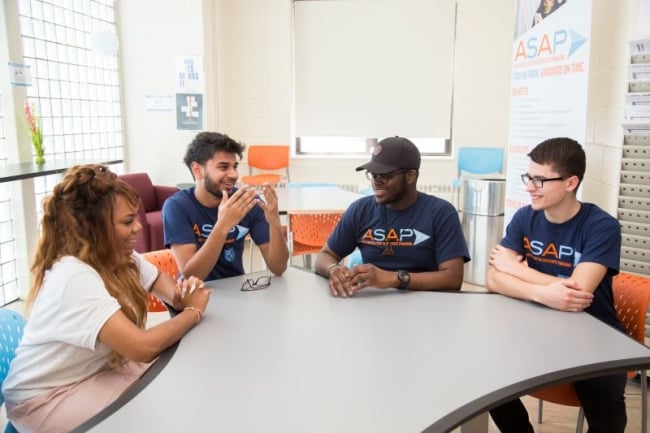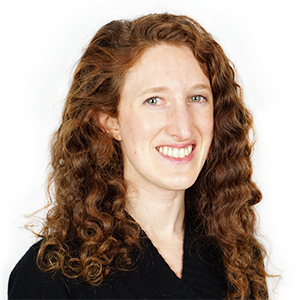You have /5 articles left.
Sign up for a free account or log in.

Initiatives to replicate CUNY ASAP are on the rise.
CUNY ASAP
College leaders are launching new, large-scale efforts to replicate and scale the Accelerated Study in Associate Programs, better known as ASAP, an academic support program for low-income students started in the City University of New York system.
The program, originally founded in 2007 at six CUNY community colleges, is known for its comprehensive wraparound support services, including intensive, personalized academic advising, and its commitment to covering tuition and textbook costs, campus fees, MetroCards, and various other expenses that remain after students have received state and federal financial aid.
CUNY also in 2015 launched Accelerate, Complete, Engage (ACE), a similar support model for students earning bachelor’s degrees. It is offered at six of the system’s four-year institutions. The system now has a team dedicated to helping other institutions, that are part of a network called ASAP|ACE National Replication Collaborative, and that are developing their own versions of these programs.
ASAP’s reputation has risen to prominence in recent years. What started out as a local high-touch support program has become the focus of multiple, external research studies. It also has been replicated across the country, at campuses large and small, from Blue Ridge Community and Technical College in West Virginia to the San Mateo County Community College District in California, and touted by advocates as a proven solution to low community college completion rates at state and national levels.
Programs based on the ASAP and ACE models have launched at 14 institutions in seven states—and counting. State University of New York system chancellor John B. King Jr. set a goal in his 2023–24 academic year policy agenda to extend programs based on ASAP and ACE to 10 system campuses.
The State Higher Education Executive Officers Association also announced a partnership in June with the ASAP|ACE National Replication Collaborative. The association is creating a “college completion coalition learning community” that brings together teams of higher ed leaders and representatives of state higher education agencies from five states interested in implementing ASAP statewide. Selected teams will receive $50,000 planning grants and guidance from CUNY staff members to draft long-term plans for developing their own programs. Meanwhile, some ASAP proponents have called for Congress to consider funding these programs nationally.
Katherine Giardello, senior policy adviser at the collaborative, said in written responses to questions from Inside Higher Ed that scaling these programs nationally “holds great promise for generating significant and far-reaching effects.”
“By observing the increases in associate degree completion rates within the CUNY system as ASAP expanded, there is reason to be optimistic about the potential impact of scaling the model in other higher education systems,” she wrote. “The ripple effects of a national scaling of ASAP could be transformative.”
John Lane, vice president for academic affairs and equity initiatives at SHEEO, said although ASAP programs have cropped up at individual institutions across the country, there’s growing interest in statewide rollouts of the model. He believes that development is partly an outgrowth of the pandemic and the equity gaps in higher ed it revealed and exacerbated.
“What other states are doing is they’re looking at their circumstances, and they’re saying, ‘There’s a holistic model that meets the needs of the whole student. What can we do to right-fit CUNY ASAP?’” Lane said. He believes a statewide approach will make it easier to spread the word about these programs to students and secure state appropriations to implement and scale them.
Many campus leaders and researchers are eager to see these programs take off, given the studies suggesting the program significantly enhances student outcomes, including completion rates and future earnings. However, scaling these programs comes with high up-front costs—thousands of dollars per student—and the existing research leaves some outstanding questions about how to get underserved students across the graduation stage.
What the Research Says
An initial study of ASAP at CUNY by MDRC, a nonpartisan research group, found that the program nearly doubled graduation rates, using a sample of about 900 students from three CUNY community colleges. The study, published in 2015, found that about 40 percent of the ASAP students earned an associate degree in three years compared to about 22 percent of their peers in a control group.
“It showed some of the highest impacts on college completion that we had ever seen,” said Colin Hill, technical research analyst for postsecondary education at MDRC. “So, obviously, any researcher’s question immediately is going to be was it something special about CUNY or New York City, or the way it was implemented there, or is the program replicable? Is it scalable?”
MDRC continues to research ASAP and some of its various iterations to track results, including programs adopted at three Ohio community colleges in 2014. The colleges developed a slightly modified version, giving students gas and grocery cards as opposed to MetroCards, for example.
The most recent report from MDRC on Ohio ASAP, released this April, found similar good news about graduation rates—about 44 percent of program participants had graduated when the team followed up six years later, relative to about 29 percent of the control group. Among ASAP students, about 14 percent went on to earn a bachelor’s degree, compared to almost 9 percent of the control group. The report also took a first look at labor market outcomes for these students. While they were employed at similar rates as their peers, program participants earned $19,573 on average six years out, 11 percent more than similar students not in these programs, who earned $17,626 on average. (The earnings data included all students in the study, regardless of whether or not they graduated or were employed at the time.)
Hill said MDRC researchers also plan to evaluate the earnings data of the Ohio programs at the 10-year point, but these initial results are promising. He believes the research supports the benefits of replicating ASAP, and the more iterations of the program there are, the easier it is to “further the evidence base” and learn more about how these programs affect student outcomes.
“We want as many data points as possible,” he said, noting the difficulties of teasing out which supports, or ingredients, are making the most difference.
“The secret sauce is all of it,” he said.
Glenda Morgan, an analyst at Phil Hill & Associates, a market analysis and consulting firm focused on education technology, is less sure about the scalability of the program. She noted that, while ASAP’s graduation outcomes are impressive, it isn’t surprising to her that students required to take full course loads are graduating on time. Part-time students outnumber full-time students at community colleges.
The full-time requirement is “creating your own success in a way,” because full-time students tend to graduate more quickly than others, but many community college students have work and family responsibilities that force them to enroll part time, she said.
Morgan also noted that the most recent study on ASAP in Ohio found that about 56 percent of ASAP students didn’t graduate within six years, despite such a high level of support.
“It’s great that we had success … but what is happening with the other students and what does that tell us about what else we need to address?” Morgan said. “Because if you’re throwing that much effort at students, surely you need a higher completion rate. What else is going on?”
Hill agreed that, while the ASAP model offers a lot of supports intended to make full-time enrollment possible, “the reality is that many community college students are dealing with a lot of competing priorities, and for many full-time enrollment is just not a possibility. Any scaling of the ASAP model requires us to reckon with this question of can it work for part-time students.”
That’s part of the reason why Lorain County Community College, one of the colleges in Ohio, started offering a version of its ASAP program specifically for part-time students. MDRC is starting to study how that program affects student outcomes.
Hill added that there are other research questions to explore, such as why ASAP students have higher earnings on average—whether it’s because they have more stable employment, go into higher-paying jobs or are going into specific fields.
Costs and Rewards
Another frequent concern about the program is that it’s costly to colleges, at least up front.
For example, the 2015 MDRC study on CUNY ASAP estimated that over three years, the ASAP program resulted in $14,029 more in direct costs per ASAP student than other students, including $6,238 on administration and staffing, $3,305 on financial supports, $2,927 on student services and $1,558 on course enrollment. A 2020 study of the Ohio ASAP model found a cost of $5,521 more per student than non-ASAP students. Both studies concluded, however, that cost per degree was lower for ASAP students compared to their peers because a larger share graduate on time.
The program can also require extensive planning and restructuring. A study about the scaling of the program at Bronx Community College, from a cohort of 750 to 4,500 students—about half of the student body—also found that the expansion led to major structural changes to processes across the institution, including enrollment and course scheduling. The 2020 study, from the Community College Research Center at Columbia University, concluded that expanding ASAP can motivate shifts at an institutional level that help all students and also may require “more systematic changes” at the college.
“You’re talking giant amounts of money and giant amounts of effort,” Morgan said.
Giardello noted that “much has been written about the cost of implementing the program,” and those estimates are important for higher ed leaders replicating the program to keep in mind as they’re planning and budgeting.
At the same time, “we have seen the programs begin to ‘pay for themselves’ reasonably quickly due to increased course taking, retention/persistence, and graduation rates,” she wrote. She added that there are also wider-scale ripple effects to consider, including that “more college graduates generally yield higher tax bases, lower public benefits spending, and higher civic engagement.”
Hill said as the research base behind the ASAP model grows, he believes it can attract more funding for replication efforts at the state and federal level.
“Students are going on to earn degrees, get better jobs, earn more money, and that obviously has spillover to the students themselves, to their institutions, to their communities, to their families,” he said.





